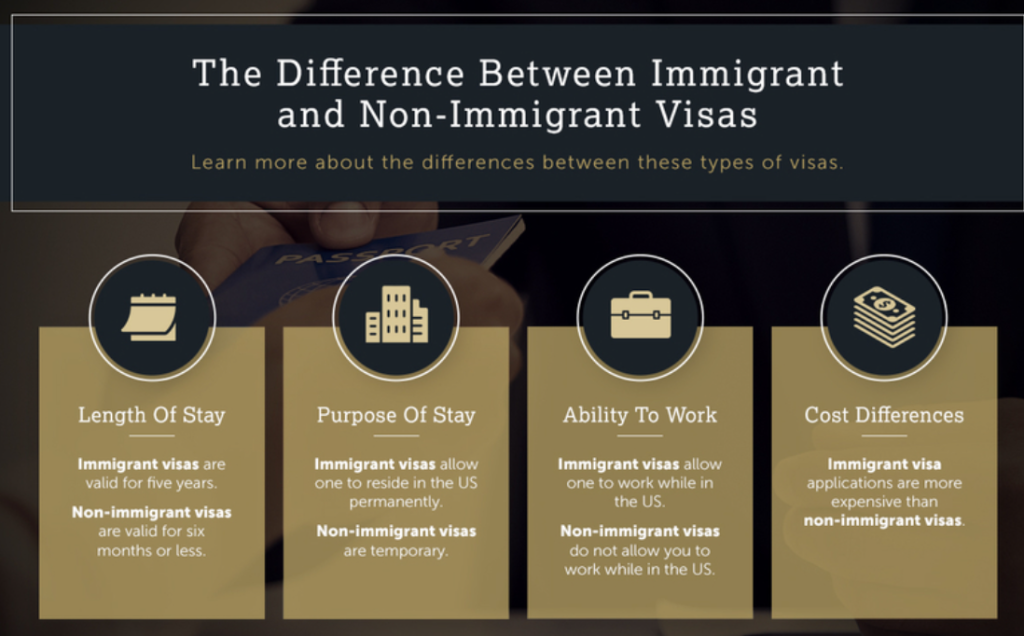
A nonimmigrant visa is a visa that allows a foreign citizen to enter the United States for a specific, temporary purpose, such as tourism, business, or study. An immigrant visa is a visa that allows a foreign citizen to live permanently in the United States.
Here is a table that summarizes the key differences between nonimmigrant and immigrant visas:
| Characteristic | Nonimmigrant Visa | Immigrant Visa |
|---|---|---|
| Purpose | Temporary stay in the United States | Permanent residence in the United States |
| Eligibility | Foreign citizens who meet certain requirements, such as having a valid passport and meeting the purpose of the visa | Foreign citizens who meet certain requirements, such as having a sponsor in the United States or being a qualified worker |
| Duration of stay | Varies depending on the type of nonimmigrant visa | Permanent |
| Ability to work | Varies depending on the type of nonimmigrant visa | Yes, with certain restrictions |
| Ability to apply for a green card | Yes, for certain types of nonimmigrant visas | Yes, for all immigrant visas |
It is important to note that there are some exceptions to these general rules. For example, some nonimmigrant visas, such as the H-1B visa for specialty workers, allow the holder to apply for a green card. Additionally, some immigrant visas, such as the K-1 visa for fiancé(e)s, have specific requirements that must be met.


Certainly! The primary difference between nonimmigrant and immigrant visas lies in the intention of the visitor and the duration of their stay in the United States. Here’s a breakdown:
1. Nonimmigrant Visa:
Purpose: Issued to foreigners who intend to enter the U.S. on a temporary basis. This includes tourism, business, temporary work, or study.
Characteristics:
- Duration: Nonimmigrant visas are typically issued for a specific duration. The duration depends on the type of visa.
- Intention: It is essential for nonimmigrant visa holders to demonstrate their intent to return to their home country after their visa expires.
- Types: There are various types of nonimmigrant visas including, but not limited to, B1/B2 (business/tourism), F1 (student), H1B (specialty occupation work), and J1 (exchange visitor).
- Limitations: Restrictions can be placed on activities the visa holder can partake in, e.g., a tourist visa holder cannot legally work in the U.S.
2. Immigrant Visa:
Purpose: Issued to foreigners who wish to live permanently in the U.S.
Characteristics:
- Permanent Residency: Immigrant visa holders generally become lawful permanent residents (often referred to as “green card” holders) upon entering the U.S. and passing through a port of entry.
- Intention: The intention of immigrant visa applicants is to reside in the U.S. permanently. They often undergo more rigorous scrutiny during the application process.
- Types: There are several categories, including family-sponsored visas (e.g., for spouses, parents, or children of U.S. citizens or lawful permanent residents), employment-based visas, and diversity visas (issued through a lottery system).
- Path to Citizenship: Immigrant visa holders (or green card holders) have a path to U.S. citizenship if they meet certain conditions after a specified number of years.
Thanks for sharing “This is best part of blog
1. Nonimmigrant Visa:Purpose: Issued to foreigners who intend to enter the U.S. on a temporary basis. This includes tourism, business, temporary work, or study.
Characteristics:
2. Immigrant Visa:Purpose: Issued to foreigners who wish to live permanently in the U.S.
Characteristics:
Nonimmigrant visas are issued to people who want to visit the United States for a specific purpose, such as tourism, business, education, or work. There are many different types of nonimmigrant visas, each with its own specific requirements.
Immigrant visas are issued to people who want to move to the United States permanently. There are several different ways to obtain an immigrant visa, including through family sponsorship, employment sponsorship, or the diversity visa lottery.
Very helpfull information thanks for sharing
Thank you for addressing this common confusion. This post is not just informative but also very reader-friendly. It’s a great introduction to the world of US visas.
Your explanation of nonimmigrant and immigrant visas is invaluable. Thanks for making these visa categories more understandable for applicants.
“Nonimmigrant visas are for temporary visits to the USA, while immigrant visas are for those seeking permanent residency.”
Understanding the distinction between nonimmigrant and immigrant visas is crucial when navigating U.S. immigration processes. Nonimmigrant visas are suitable for those seeking temporary stays for specific purposes, while immigrant visas are for those intending to establish permanent residency. It’s important to select the appropriate visa category based on your intentions and eligibility, as the application processes and requirements differ significantly between the two. Consulting with immigration authorities or seeking legal advice can be helpful to ensure you choose the right visa for your situation.
Your blog is a beacon of clarity in the world of visa information. The way you’ve simplified the distinctions between Nonimmigrant and Immigrant visas is commendable. I appreciate the effort you put into creating this resource.
thanks for sharing these terminology and their Characteristics is essential for immigrants peoples
This is a great article that clearly explains the difference between nonimmigrant and immigrant visas. It is important to understand the difference between these two types of visas so that you can apply for the correct one.
Thank you for this insightful article! It’s important to understand the clear distinction between nonimmigrant and immigrant visas. This information is invaluable for anyone navigating the complex world of U.S. immigration. Your clear and concise explanation truly helps demystify the process and allows individuals to make informed decisions regarding their visa applications. Well done
Thank you for sharing this post! It was really helpful and insightful. I’m definitely going to share it with my friends and family who are considering immigrating to the United States.